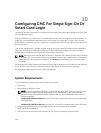
Client Systems
• For only Smart Card login, the client system must have the Microsoft Visual C++ 2005 redistributable.
For more information see www.microsoft.com/downloads/details.aspx?FamilyID=
32BC1BEEA3F9-4C13-9C99-220B62A191EE&displaylang=en
• For Single Sign-On or smart card login, the client system must be a part of the Active Directory
domain and Kerberos Realm.
CMC
• Each CMC must have an Active Directory account.
• CMC must be a part of the Active Directory domain and Kerberos Realm.
Prerequisites For Single Sign-On Or Smart Card Login
The pre-requisites to configure SSO or Smart Card logins are:
• Set up the kerberos realm and Key Distribution Center (KDC) for Active Directory (ksetup).
• A robust NTP and DNS infrastructure to avoid issues with clock drift and reverse lookup.
• Configure CMC with Active Directory standard schema role group with authorized members.
• For smart card, create Active Directory users for each CMC, configured to use Kerberos DES
encryption but not pre-authentication.
• Configure the browser for SSO or smart card login.
• Register the CMC users to the Key Distribution Center with Ktpass (this also outputs a key to upload to
CMC).
Generating Kerberos Keytab File
To support the SSO and smart card login authentication, CMC supports Windows Kerberos network. The
ktpass tool (available from Microsoft as part of the server installation CD/DVD) is used to create the
Service Principal Name (SPN) bindings to a user account and export the trust information into a MIT-style
Kerberos keytab file. For more information about the ktpass utility, see the Microsoft Website.
Before generating a keytab file, you must create an Active Directory user account for use with the -
mapuser option of the ktpass command. You must use the same name as the CMC DNS name to which
you upload the generated keytab file.
To generate a keytab file using the ktpass tool:
1. Run the ktpass utility on the domain controller (Active Directory server), where you want to map
CMC to a user account in Active Directory.
2. Use the following ktpass command to create the Kerberos keytab file:
C:\>ktpass -princ HTTP/cmcname.domain_name.com@REALM_NAME.COM - mapuser
dracname -crypto DES-CBC-MD5 -ptype KRB5_NT_PRINCIPAL -pass * -out c:
\krbkeytab
NOTE: The cmcname.domainname.com must be in lower case as required by RFC and the
@REALM_NAME must be in uppercase. In addition, CMC supports the DES-CBC-MD5 type of
cryptography for Kerberos authentication.
A keytab file is generated that must be uploaded to CMC.
145


















